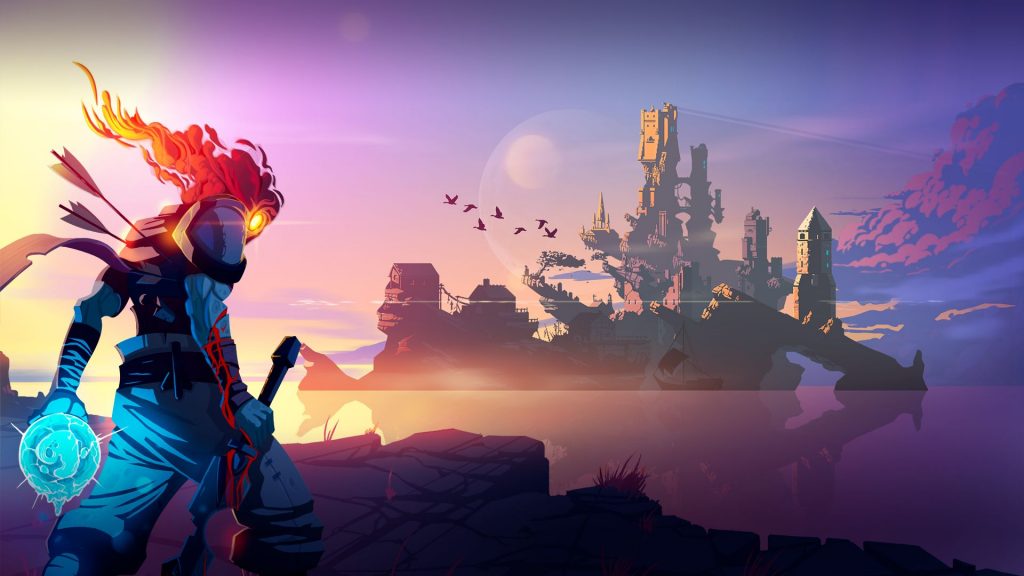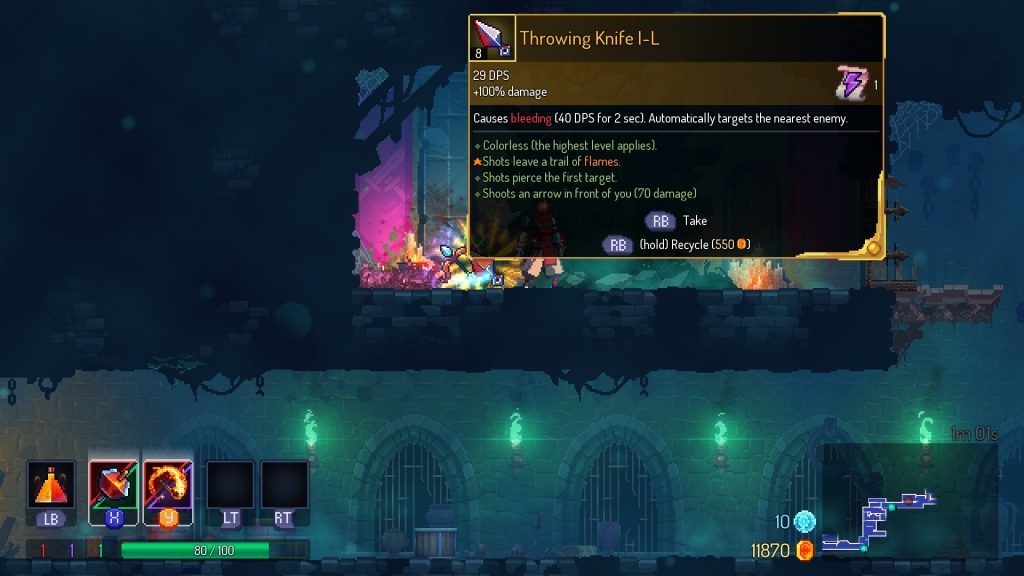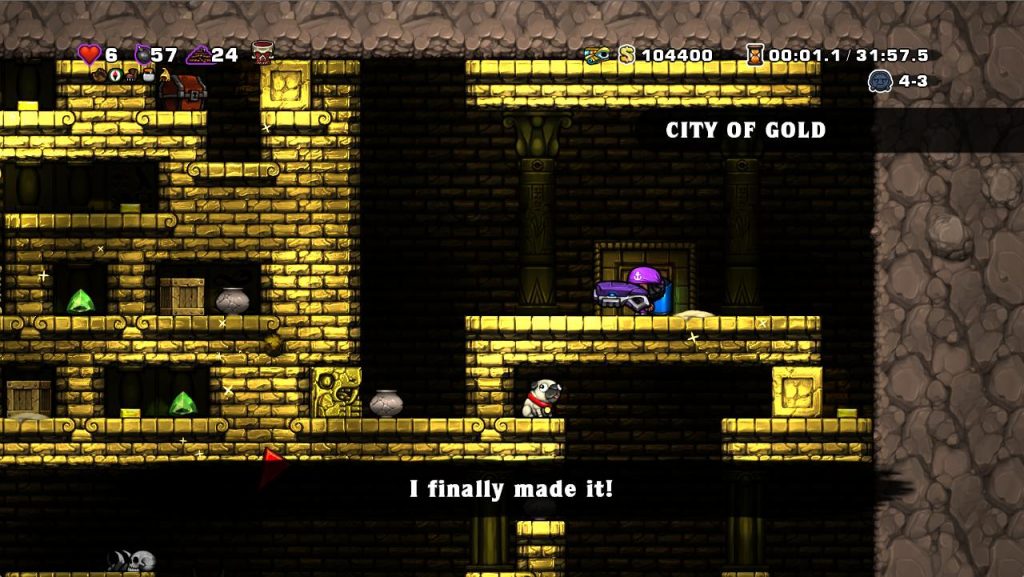Dead Cells is a Metroidvania all about jumping, slamming, slashing, and blasting your way to glory. It’s also a roguelite, meaning that glory is earned across countless runs and with the help of an ever-growing arsenal of tools and abilities. Though these genres seemed hard to blend in the past, with games like Rogue Legacy and Sundered finding only mixed success. Dead Cells creates a formula that combines aspects of both in surprising and inventive ways. It’s just a shame about, well, everything else.
When it comes to playing Dead Cells, you’d be hard pressed to criticize the way it controls. As you jump from room to room, roll between incoming enemy attacks, or control a vast majority of the game’s massive arsenal of different tools, the mechanics feel impactful and satisfying. There are four item slots for players to work with, and the tools you can put into those slots can end up feeling incredibly different from each other. Whether it’s long-range weapons like bows or magic, melee weapons, or traps like turrets, each have abilities that can work great on their own, and even better when synergised with another aspect of your toolkit. You could set a trap on the ground to snare an enemy, for example, and then spread fire across the ground so they’re trapped within for big damage.
Every weapon in the game has their own statistics and bonuses, which range from fancy abilities like “throws out a bomb when used,” to more subtle passive effects like “+100% damage to a burning target.” These effects can be rerolled for a small price every so often, so as you progress through the game you can gradually craft a loadout that works perfectly for what you have. Unfortunately, like most roguelites, a single playthrough/run of Dead Cells is made or broken by the items you get on each run, and many of the items randomly doled out are either outright bad, or so much worse than the best items that it feels pointless to do anything other than restart.
When you start your very first run you have a simple choice between a basic sword, shield, or bow. Once you’ve played the game a little, however, you’re able to spend your hard-earned cells on a new bonus that makes it so one weapon from each of those weapon types is randomly selected at the start of each run. The weapons pull from whatever you have unlocked, but it felt to me that the more you unlock, the worse this feature becomes. It’d be like if filling out the Pokédex in Pokémon actively made setting up a party significantly harder; that’d be weird considering how much the game encourages you to use it right?
There are lots of weapons in Dead Cells that just end up putting you at a disadvantage. Weapons like whips or hammers can be weak and slow, making your game harder from the get-go due to random chance. When this happens there’s pretty much nothing stopping you from restarting until you get at least one weapon that’s more usable, or, if you really want to be secure, one of the more blatantly game breaking items. Items like Ice Blast or the Assassin’s Dagger are so ridiculously good at working with each other, and controlling enemies in the game, that by not having them, I felt like I was having a lesser experience.
The only seemingly guaranteed “good” items that you can get are the legendary weapons that drop from bosses, which have all sort of strong attributes. Those attributes could very well be on one of the many mediocre weapons in the game though, because of the way the unlock system propagates the upgrade pools thoughtlessly. The more I played of Dead Cells, and the more I unlocked, the more I found myself regretting how much I’d unlocked, and the game could really use something like an unlockables toggle to help curb this. Most roguelites, like The Binding of Isaac, make starting loadouts tied to characters, or curb your chances of getting better items as you unlock more and more with specific reward pools, but Dead Cells doesn’t. After spending so long in early access, especially on a marketplace filled to the brim with games that have been solving these problems for years, the unthought design becomes less understandable.
Another case of this poor direction is with Scrolls. Scrolls help power your character up in one of three ways; skill trees divided by color. Every time you pick up a scroll you’re presented with a choice of buffing one of these stats, but every time you upgrade a stat, it also upgrades the enemies you’ll be facing. I find this particularly baffling, because the game doesn’t tangibly express that this would be the case anywhere, and the game is already actively buffing enemies the further you get, which would make it seem like a no brainer to take all the help the game gives you.
I think the way Scrolls work, and the way that unlocking items can make your experience worse, ends up contributing to the gradual desire to give up that permeates Dead Cells. What’s the point in continuing to fight on and on if my only reward is playing through the same game, hoping to play through in the exact same way, where none of the future upgrades have much promise? Though plenty of games can lose their steam as you gradually uncover their secrets, Dead Cells feels like the type of game where you can get nearly every fun experience by actively not beating it, which ruins the idea of unlocking everything that’s so often a selling point of the genre.
It certainly doesn’t help that bosses are tedious, unfun damage sponges that repeat the same two or so mechanics in a loop for minutes on end, leaving little nuance or joy in figuring out a strategy, and continuing to persist for far too long even when you have one of those one in a million amazing runs where everything seems to be going great. The first boss I fought left me sort of cold, especially once I realized how, unless I had an ideal trap setup, every encounter with it would be a battle of attrition, with health bars slowly whittling away. When I got to the last boss in Dead Cells, the fight was so egregiously unfun and obnoxious, and designed to prevent even those ideal trap runs from working, that it made me lose all enthusiasm I had towards playing more of the game.
It makes sense for bosses to be difficult, but there’s a difference between difficulty and complete annoyance, and Dead Cells’ bosses are unfortunately the latter. There are only four unique bosses in the game, and one of those bosses is completely optional. The lack of variety and overall monotony of running through and fighting the same three bosses pretty much every run eventually starts to wear down on you, which seems sort of silly when the sheer amount of ridiculous bosses is a feature most people love about Metroidvanias. Even from a roguelite perspective though, the lack of interaction between your character upgrades and the bosses themselves ends up feeling disappointing.
Many roguelite games sell you on their variety and provide opportunities where you’re able to do all sorts of wild things and, if you’re strong enough, completely melt bosses within the span of seconds on a good run. In Dead Cells, a good run is dictated entirely by “did you get the wolf trap, did you get a turret, okay you just mash those over and over to win.” Even most of the debuff items in the game become gradually resisted by the boss over the duration of a fight, which seems like a baffling design decision that serves only to arbitrarily increase the difficulty of these encounters. Problems like these wouldn’t even necessarily be that easy to fix, since the issues with most of the weapons are so core to their identity, that a simple buff or nerf would hardly solve much of anything.
Another way of upgrading in the game is the Mutations feature. You’re allowed to pick three mutations, one at the end of each of the first three levels, but most of them are so passive that I was never really super psyched to use them. In fact, most of the time, like with weapons, I was only ever chose the same three mutations: one that buffed my attack, one that buffed traps, and one that increased the effectiveness of my debuffs. I think it’s exceptionally weird that there are actually so many to choose from, and that while it seems the idea behind them is to pick and choose based on whatever loadout you’ve fallen into, so many of them are so useless that I just wanted to stick to the blanket-use broken ones.
For example: One ability makes it so that you do more damage on enemies that have been debuffed, while another makes it so that you regain 3 HP for every enemy killed. That first ability is exceptionally good, especially if you have a lot of trap weapons like turrets or ongoing damage like a burning bonus, but the second is only really useful for the first couple levels, and even that is a generous assessment, considering that your health will quickly climb into the thousands. Though Mutations can be leveled up with scrolls, the amount by which it helps is very small, and again, using a scroll will just make the game harder for you, so there’s no reason to not just take those really blatantly good Mutations.
A lot of the upgrades take way too many runs to get, which is made even weirder by my earlier point of so many of them being useless. This ended up feeling exceptionally bad when I’d put a ton of time and effort into unlocking a new item or ability, and it just turns out to be incredibly subpar or unusable. There are also things like the permanent upgrade to how many health potions you can carry, which end up feeling like an artificial timegate into how long it will take you to actually be able to beat the game instead of a fun optional upgrade, because of how tough enemies and later bosses get.
One of the ways that Dead Cells does good by its genre however, is the way in which it translates the underpinnings of a Metroidvania into a procedurally generated roguelite. Just like a standard Metroidvania, you gradually unlock new methods of traversal, which in turn let you explore more areas of each map on more runs. These upgrades are, in order, the ability to grow climbable vines, the ability to teleport through coffins, the ability to smash through certain surfaces, and the ability to wall jump. Each of these powers feel great once you get them, and it’s incredibly satisfying figuring out what previously confusing elements of an area’s environment are.
However, in true Dead Cells fashion, everything else about this great idea is completely underutilized or frustrating. For example, all of these upgrades are hidden in much harder challenge areas that can be accessed as an alternate path through the game. These areas are difficult, but not particularly through any complex or interesting way, but rather by the way that enemies placed within them use large area of effect attacks, and take what feels like years to kill. The areas are also completely pointless to go through once you’ve gotten the upgrade that’s hidden within them as well, meaning that you lose whatever chance at variety you could’ve had for any given run’s levels (though again, since these levels are pointlessly hard it’s unfortunately not much of a loss).
The idea of harder challenge zones has been been explored by other games. In Spelunky you can find hidden entrances and go through different zones depending on choices, and are often rewarded for doing so with better tools or resources. In Dead Cells you’re not really rewarded after you do it the first time, and the game actively incentivizes you to want to go back to the normal routes instead, because they offer most of the same rewards, and have more ways to use your unlocked abilities. For pure environmental difference as well, The Binding of Isaac gradually randomizes what levels you’ll go through on each run, meaning that you’ll have a decent amount of variety everytime you play the game. Once you’ve unlocked those bonus abilities, almost all of your runs in Dead Cells will be exactly the same.
I think that the idea of permanent upgrades to things like traversal are super cool, but they’re severely underutilized, and could be a whole lot more. A lot of the interactions you end up having with things like the wall jump or upgraded ground slam are just things you’ll do once to unlock an item, much like the way you get those upgrades in the first place. If the game actually went out of its way to add more moving parts to levels the more you unlocked ways of traversal, I think that would be really cool and help the game stay fresh as you went on, instead of starting to feel like a stale bag of chips as time goes on.
It’s annoying how hard it is to actually unlock these features too. Before you can unlock most weapons and mutations you have to get a blueprint for them, which are rare drops from the various enemies in the game. Almost every single enemy type has at least one blueprint tied to it, and eventually the process of unlocking a lot of these blueprints just feels like annoying chance. To mitigate this, there’s an item you can unlock called the Hunter’s Grenade, which guarantees a blueprint drop from whatever enemy you hit with it. Unfortunately, even this mitigation is incredibly flawed because using the Grenade immediately upgrades the enemy to a much stronger version of itself that can infinitely summon additional smaller enemies all around it.
Using this Grenade also doesn’t mean they’ll drop the blueprint when you defeat them either, which would be a reasonable tradeoff, instead you have to stand still and use another item to drain the blueprint from them when they’re at low health. This is extremely tedious and annoying to do when the enemy is constantly spawning quick attacking enemies all around you, and even harder in later stages when you’re making already difficult enemies even stronger. I don’t understand why they couldn’t have just made it so that when you beat an enemy for the first time they dropped their blueprint, since that’s how other games do it, and it feels far more rewarding there.
If there was a perfect exemplification of the constant aping that Dead Cells pulls from other games, it would have to be through its writing. Countless rooms procedurally placed throughout the island paint the same tired scenarios of tragic death, trailing off doctor’s logs, and vague references to rich lore™ just like the Dark Souls! In one room in particular, there exists what almost feels like a requirement for games at this point; a bonfire with the words “GIT GUD” inscribed on the wall. It’s ironic, that the developers would pull this phrase for a purely referential joke, because that toxic ideology that misrepresented the Souls series for so long is actually one that applies perfectly to Dead Cells. You’re going to learn the exact boring way to play that lets you win everytime, and there’s no room for variety or fun beside that.
It’s been odd for me to see the consistent mind-blowing praise that Dead Cells has gotten over the last month or so, now that I’ve finally gotten my hands on it. I had always had a positive opinion on Dead Cells since I first saw it at last year’s PAX East, but now that I’ve really dug into it to the degree of other roguelites, that honeymoon period quickly ended. I think the early hours of the game, oh those halcyon days, are still good, and contain the underpinnings of a great experience. It’s a shame that by the time I reached the end, I was coming away uninterested, and unfulfilled.












